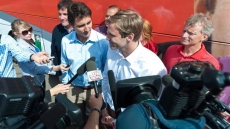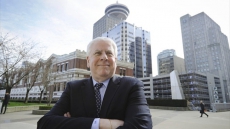SIDNEY, B.C. — A shiny, chrome-coated Beechcraft 18 aircraft that was once used by former provincial cabinet minister Phil Gaglardi to inspect the province's highways is one of the historic exhibits at British Columbia's Aviation Museum.
Gaglardi's tricked-out Beechcraft Pac Aero Tradewind, which landed in the government's books as a snowplow, is one of the many aviation exhibits the Victoria-area museum's volunteers have painstakingly restored for public viewing.
Located in a hangar adjacent to Victoria International Airport, the museum is dedicated to preserving aviation heritage.
The 23 military and commercial aircraft on display in two hangars comprise the bulk of the exhibits, but there's more, including airplane engines, airport radios and the uniforms worn by fighter pilots and flight attendants.
The stylish apparel includes brown leather bomber-style jackets worn by Royal Canadian Air Force fighters and the red, blue and orange 1970s polyester uniforms sported by flight attendants at the now defunct Canadian, Pacific Western and Wardair airlines.
Every aircraft at the museum has history and its arrival at the aviation museum is usually accompanied by a unique story, which the volunteer staff (mostly retired aircraft mechanics, pilots and administrators) are only too happy to tell.
The 1950s vintage Trans Canada Air-Lines Vickers Viscount 757 passenger airplane was purchased for $1 and placed on a barge to Vancouver Island, where the volunteers restored its shine and grandeur.
Visitors entering the passenger area are immediately amazed at the large amount of leg room and the vastness of passenger space compared to today's commercial aircraft. The Viscount includes a room to hang coats and every seat has an ashtray — cigarettes only, no cigars or pipes.
The Avro Anson Mk 11 reconnaissance and training aircraft is a poignant exhibit.
Earlier this month, family, friends and air force members from Canada and abroad gathered at the museum's hangar for a funeral reception following the Nov. 10, burial of four airmen who died in 1942 just west of Victoria.
Three British airmen and one Canadian officer were declared missing in action until the Anson's wreckage and their bodies were discovered by a forestry crew last year.
Retired aircraft mechanic Stonewall (Stoney) Jackson, 82, stands beside the museum's Avro Anson, explaining the aircraft was a perfect training machine for Second World War pilots and navigators.
Jackson said he comes to the museum once a week to tell stories about the aircraft exhibits, and he has details right down to the specifics of the engines and which uniforms come with pre-polished buttons and which do not.
"We have a fairly wide collection of airplanes," he said. "It's not perfect, but it's OK. Everybody here is a volunteer."
Aviation Museum Society president John Lewis said the museum permits visitors to tour its restoration room, the place where volunteers get aircraft polished and fit for display.
On this day, the room smells like wood glue, buzzes from the sound of drills and glistens with light as the fall sunshine reflects beams of light off the chrome fuselage of Gaglardi's Beechcraft.
"One of the things we pride ourselves on is if you want a guided tour, you can have one," said Lewis. "Or you can wander around by yourself."






